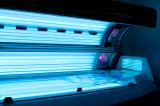Ultraviolet (UV) Radiation Tanning Equipment
Radiation Facts
- Tanning can increase your chances of developing skin cancer.
- Lighter colored skin is more sensitive to UV rays than darker skin because darker skin has more pigmentation, which provides greater protection from UV rays.
- UV radiation can cause temporary and permanent eye damage.
Tanning is your skin's self-defense against burns from ultraviolet (UV) rays. Skin cells react by producing more pigment (color) as a shield. Too much exposure to these rays can cause wrinkling of the skin at an early age, skin rashes, and eye injury.
About Ultraviolet (UV) Radiation Tanning Equipment
Sun lamps and tanning equipment emit rays of ultraviolet (UV) radiation. Exposure to UV radiation, whether from tanning equipment or from the sun, increases your risk of developing skin cancer.
There are three types of UV rays that come from the sun:
Ultraviolet A rays (UVA)
- The atmosphere does little to shield these rays—most UVA radiation reaches Earth’s surface.
- UVA rays cause skin aging, and eye damage and can lower your body’s ability to fight off illness. UVA rays also contribute to the risk of skin cancer.
Ultraviolet B rays (UVB)
- The Earth’s atmosphere shields us from most UVB rays—the amount of UVB rays that reach the Earth’s surface depends on latitude, altitude, time of year and other factors.
- UVB rays cause sunburns, skin cancer, skin aging, and snow blindness (a sunburn to your cornea that causes a temporary loss of vision) and can lower your body’s ability to fight illness.
Ultraviolet C rays (UVC)
- UVC rays do not reach the Earth’s surface because they are completely absorbed by the atmosphere.
- Harmful effects from UVC rays are minimal.
Most sun lamps and tanning equipment emit UVA rays. UVA rays are sometimes known as “tanning rays,” and are less likely to cause sunburn than UVB rays. However, that does not make UVA radiation safe. UVA rays may be linked to melanoma (the deadliest kind of skin cancer) and, like UVB rays, they can damage your body’s ability to fight illness.
UV radiation from tanning equipment can also affect the eyes. The internal and external structure of the eyes are sensitive to UV exposure and require proper protective eyewear, such as special safety goggles. Ultraviolet radiation damage to the eyes can result in eye-related diseases such as cataracts, snow blindness, or certain eye cancers.
What You Can Do
- Avoid tanning lamps, beds, and booths. If you do use tanning equipment, always use protective eyewear that provides 100% UV ray protection.
- Conduct a monthly self-check. The self-check should include looking for any skin abnormalities. Have a friend or family member check your back and scalp. Look for bumps or sores that don't heal or for moles that have changed size, color, or shape. It’s important to visit your physician or a dermatologist for regular skin checks and to have any new or changing mole evaluated. When caught early, most cases of skin cancer can be cured.
- Become familiar with your state’s laws and requirements regarding indoor tanning facilities. Some states now ban teens and young adults from indoor tanning facilities, or require parental approval for them to access the tanning equipment.

